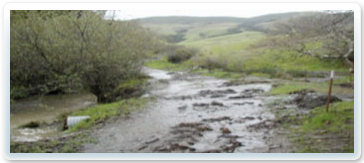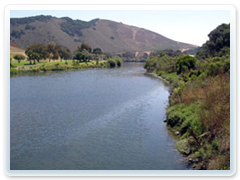Waterway Management Plan
Problem IdentificationFlooding can occur even during the 10 or 20-year flood recurrence interval in some locations along SLO Creek, due to flow constrictions at bridges and other areas of limited channel conveyance. Denuded banks and erosion can add plant debris and sediment that is later re-deposited downstream. Undermined trees may topple into the channel in some areas during the next large flood event. Streambank vegetation can collect debris, reducing channel capacity and deflecting flows against banks.
A set of rainfall-runoff and stream flow computer models that numerically describe the hydrologic and hydraulic performance of the watershed and stream system was developed as part of the SLO Waterway Management Plan (2003). The modeling results, along with existing reports of historic flood damage, provide a comprehensive picture of where flooding is likely to occur in the future. The hydrologic and hydraulic models provide information on flood channel conveyance capacity, flood reoccurrence intervals, and estimates on the extent of floodway. Figure 3-2a of the SLO Waterway Management Plan summarizes the flooding problems that occur along SLO Creek and its principal tributaries. |
Management Needs for the San Luis Obispo Creek WatershedThe feasibility of providing 100- year flood protection for developed properties along all of the major streams in the watershed is limited by the large amounts of runoff generated during storms. The terrain and hydrology of the watershed are conducive to frequent and widespread flash flooding along the major streams. The hydrologic analysis performed for the SLO Waterway Management Plan revealed that urbanization of the watershed has had only minor effects on larger flooding events; severe flooding was common even under pre-development conditions. To a certain extent flooding is inevitable and the most cost effective/best strategy may be to avoid building on flood prone areas in the lower watershed, selectively purchasing buildings subject to recurrent flooding, and fix only the generally localized areas where flooding occurs to reduce the frequency and depth of flooding and flood damage. Flood-proofing of buildings in flood prone areas can also be an important strategy. The SLO Waterway Management Plan included a number of recommendations for managing vegetation in channels to decrease flood risk. (Please note that most of these activities require permits from regulatory agencies.)
"Management of willows at hardened bars (and other areas with dense, in-channel vegetation) is a critical maintenance need and management problem. Informed management of the flood-modified channel and banks affords an opportunity to reduce the impact of future floods. Because of system wide channel capacity constraints, perennial vegetation in the active, most efficient part of the channel should be maintained at a low level. Willows should be discouraged from re-colonizing point bars for more than two or three consecutive years. If the growth persists, there will be increased flow friction losses and sediment deposition. This will increase the depth of flooding, or cause lateral erosion, particularly at channel bends. In contrast, performing selective vegetation removal and replanting with desirable species (replacing undesirable exotic vegetation, plugging gaps in canopy cover, or planting areas denuded by the 1995 flood) will help stabilize the bank, direct deposition into toe protecting berms, and reduce the sediment supply of future floods. Detailed procedures for vegetation management are included in the SLO Land Conservancy Watershed Enhancement Plan." "Even with vegetation management, structural channel modifications will be needed to reduce flood risk in a number of areas of the City. Flooding problems along SLO Creek and proposed flood management solutions for specific areas are discussed in Section 6 of the SLO Waterway Management Plan."
Click here to access the City’s website which has the Waterway Management Plan HEC modeling files and other useful documents. |


